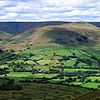
The River Manifold is a river in Staffordshire, England. It is a tributary of the River Dove.
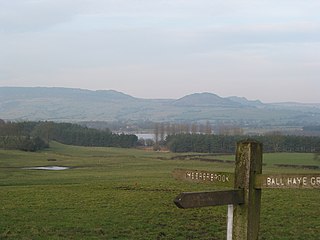
Staffordshire Moorlands is a local government district in Staffordshire, England. Its council is based in Leek, the district's largest town. The district also contains the towns of Biddulph and Cheadle, along with a large rural area containing many villages. North-eastern parts of the district lie within the Peak District National Park.

Longnor is a village in the Staffordshire Peak District, England. The settlement dates from early times, the first recorded church building being in the Middle Ages. The village was named Longenalre in the Domesday Book. Located on a major crossroads, Longnor was a significant market town in the 18th century. It lies on the north bank of the River Manifold, on a limestone ridge between the Manifold and the River Dove.

Ilam is a village in the Staffordshire Peak District of England, lying on the River Manifold. The population of the civil parish as taken at the 2011 census was 402.

The Leek and Manifold Valley Light Railway (L&MVLR) was a narrow gauge railway in Staffordshire, England that operated between 1904 and 1934. The line mainly carried milk from dairies in the region, acting as a feeder to the 4 ft 8+1⁄2 instandard gauge system. It also provided passenger services to the small villages and beauty spots along its route. The line was built to a 2 ft 6 in narrow gauge and to the light rail standards provided by the Light Railways Act 1896 to reduce construction costs.
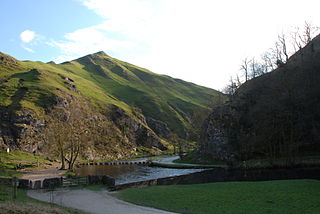
Dovedale is a valley in the Peak District of England. The land is owned by the National Trust and attracts a million visitors annually. The valley was cut by the River Dove and runs for just over 3 miles (5 km) between Milldale in the north and a wooded ravine, near Thorpe Cloud and Bunster Hill, in the south. In the wooded ravine, a set of stepping stones cross the river and there are two caves known as the Dove Holes.
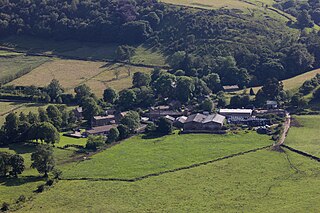
Hollinsclough is a small rural village in the county of Staffordshire in the English Midlands. It is within the Peak District National Park.

Thor's Cave is a natural cavern located at SK09865496 in the Manifold Valley of the White Peak in Staffordshire, England. It is classified as a karst cave. Located in a steep limestone crag, the cave entrance, a symmetrical arch 7.5 metres wide and 10 metres high, is prominently visible from the valley bottom, around 80 metres (260 feet) below. Reached by an easy stepped path from the Manifold Way, the cave is a popular tourist spot, with views over the Manifold Valley. The second entrance is known as the "West Window", below which is a second cave, Thor's Fissure Cavern.
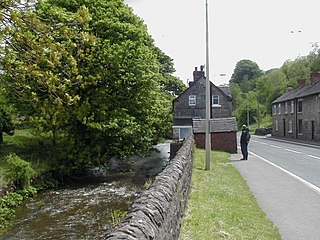
Waterhouses is a village in the south of the Staffordshire Peak District in England. It is around 8 miles from Leek and Ashbourne, being nearly the halfway point between the two towns on the A523 road, which roughly follows the southern boundary of the Peak District National Park. Waterhouses is also a civil parish, created in 1934 when the parishes of Calton, Cauldon, Waterfall and part of Ilam were merged; previously the village of Waterhouses was on the boundary of Waterfall and Cauldon parishes. The hamlet of Winkhill is also in the parish. The population of the civil parish at the 2011 census was 1,134.

Ecton is a hamlet in the Staffordshire Moorlands in Staffordshire, England. It is near the Peak District. It is on the Manifold Way, an 8-mile (13 km) walk and cycle path that follows the line of the former Leek and Manifold Valley Light Railway. Population details as at the 2011 census can be found under Ilam.

The Manifold Way is a footpath and cycle way in Staffordshire, England. Some 8 miles (13 km) in length, it runs from Hulme End (53.1307°N 1.8480°W) in the north to Waterhouses (53.0480°N 1.8654°W) in the south, mostly through the Manifold Valley and the valley of its only tributary, the River Hamps, following the route of the former Leek and Manifold Valley Light Railway, a 2 ft 6 in gauge line which closed in 1934 after a short life.

Grindon is a small village in the Staffordshire Moorlands district of Staffordshire, England. Close to the Peak District.
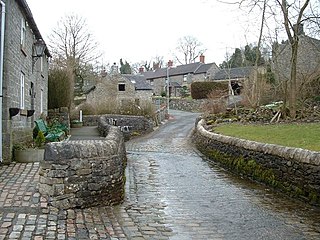
Butterton is a small village in the Staffordshire Moorlands in Staffordshire, England. It is close to the Peak District. It overlooks the Manifold Valley and Ecton Hill, which rises 1,212 feet above sea level. Butterton lies 5 miles east of Leek and roughly 8 miles from Alton Towers theme park. The village is just west of the limestone area, and so is mainly built of local sandstone. It contains a Grade II listed church. In the centre of Butterton there is an unusual ford where the Hoo Brook runs along the village street.
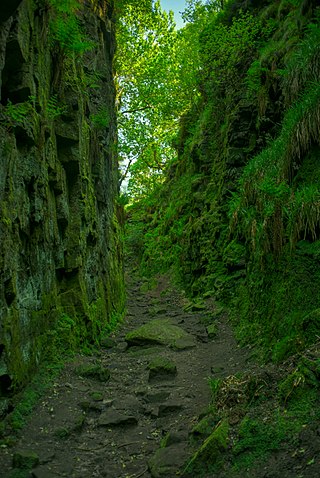
Lud's Church is a deep chasm penetrating the Millstone Grit bedrock created by a massive landslip on the hillside above Gradbach, Staffordshire, England. It is located in a wood known as Back Forest, in the Dark Peak, towards the southwest fringe of the Peak District National Park about 2.5 miles (4.0 km) west of the A53 between Leek and Buxton. Over 100 metres (328 ft) long and 18 metres (59 ft) deep, all but the upper third of the slope has slipped forward towards the River Dane. It is mossy and overgrown, wet and cool even on the hottest of days.

Warslow is a small village in the Staffordshire Moorlands of Staffordshire, England. It is located in the Peak District National Park about 10 miles (16 km) north of Ashbourne. The village lies close to the Derbyshire border.
The tiny hamlet of Ramsor in North Staffordshire played a significant part in the origins of Primitive Methodism. Listed in the Domesday Book as Ramshorn, this ancient hamlet is a typical example of the depopulation of the countryside. Very little now remains of this village apart from a few farms and cottages. The Primitive Methodist Chapel is the only surviving public building.
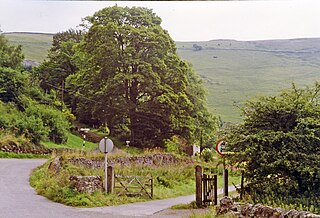
Ecton railway station was a station on the Leek and Manifold Light Railway. It served the hamlet of Ecton and village of Warslow in Staffordshire, England. It opened to the public on 29 June 1904 and was in operation for almost thirty years prior to its closure on 12 March 1934. Ecton Creamery opened in 1920 and the line was used for transporting Stilton cheese. An Ordnance Survey map published in 1922 shows a branch line running to the cheese factory. Milk was transported by road from 1932, leading to a decline in revenue for the railway. In 1937, owner London, Midland & Scottish Railway gifted the track bed to Staffordshire County Council for a public right of way, pioneering such transfers in Britain. Today, the site is part of the Manifold Way that runs between Hulme End and Waterhouses.
Redhurst Crossing was a railway station on the Leek and Manifold Light Railway, located between Wetton Mill railway station, Staffordshire and Thor's Cave railway station. Not much is documented about the halt, and the line which ran through it is now the Manifold Way.

Warslow and Elkstones is a civil parish in the district of Staffordshire Moorlands in north-east Staffordshire, England. It includes the village of Warslow and the hamlets of Lower Elkstone and Uppoer Elkstone. There is a boundary with Wetton in the east at the River Manifold. To the south is Butterton; the River Hamps forms the western boundary with Onecote.
The geology of the Peak District National Park in England is dominated by a thick succession of faulted and folded sedimentary rocks of Carboniferous age. The Peak District is often divided into a southerly White Peak where Carboniferous Limestone outcrops and a northerly Dark Peak where the overlying succession of sandstones and mudstones dominate the landscape. The scarp and dip slope landscape which characterises the Dark Peak also extends along the eastern and western margins of the park. Although older rocks are present at depth, the oldest rocks which are to be found at the surface in the national park are dolomitic limestones of the Woo Dale Limestone Formation seen where Woo Dale enters Wye Dale east of Buxton.























